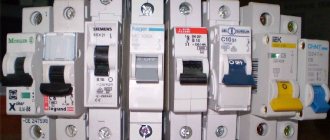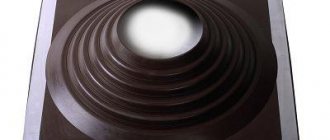To organize a trouble-free in-house power supply, it is necessary to allocate separate branches. Each line must be equipped with its own protection device that protects the cable insulation from melting. However, not everyone knows which device to buy. Do you agree?
You will learn everything about choosing automatic machines based on load power from the article we presented. We will tell you how to determine the rating to find a switch of the required class. Taking into account our recommendations guarantees the purchase of the required devices that can eliminate dangerous situations during the operation of the wiring.
Circuit breaker functions
From the name it is clear that this is a switch that turns off automatically . That is, himself , in certain cases. From the second name - circuit breaker - it is intuitively clear that this is some kind of automatic device that protects something.
Here are examples of the installation and use of such machines - when installing an apartment meter and when replacing electrical wiring in an apartment.
Now more details. The circuit breaker trips and turns off in two cases - in case of overcurrent , and in case of short circuit (short circuit) .
Overcurrent occurs due to faulty consumers, or when there are too many consumers. Short circuit is a mode when all the power of the electrical circuit is spent on heating the wires, while the current in this circuit is the maximum possible. More details will follow.
In addition to protection (automatic shutdown), machines can be used to manually turn off the load. That is, like a switch or a regular “advanced” switch with additional options.
Another important function (this goes without saying) is the connection terminals. Sometimes, even if the protection function is not particularly needed (and it never hurts), the terminals of the circuit breaker can be very useful. For example, as shown in the article Laying the input cable from the gander to the meter.
Correct terminals
If you look at individual brands of machines, you can see that if the terminal is not completely open, the wire can accidentally get into the terminal space.
When you connect wires in a panel at a height, you usually do not see the top terminal and the core is inserted there, as they say, by touch.
An electrician who tightens a terminal with an incorrectly inserted wire will not feel anything. There seems to be an effort, which means the tightening was successful.
Some even check this tightening torque using a torque screwdriver scale.
In fact, the wire will not be secured.
In good circuit breakers, such an oversight or error is simply impossible. In them, as soon as you begin to tighten the terminal, the terminal space is immediately closed with a special plate.
It can be either metal or plastic.
Another recommendation, but not a mandatory feature regarding the terminals, is an additional connector for a comb busbar.
When a number of machines are assembled in an electrical panel, they are connected to each other through just such a bus. It is very convenient and reliable.
But the problem arises if you later need to make some kind of desoldering and bring out a separate wire from this terminal.
The contact density changes, it is not fully pressed and gradually burns out. As a result, the machine has to be replaced.
So, in some models (mainly from ABB), there is an additional connector for this purpose, designed specifically for the comb bus.
The main contact remains free and you can safely connect the cable core to it without compromising the reliability of the connection.
Also look for notches on the terminals. It is advisable that they are not smooth.
With these notches, the terminal material bites into the copper core, thereby promoting better transient resistance.
Also make sure that the plastic near the screw does not come apart when tightening. You can check this right in the store using screwdrivers.
Insert the tip of one screwdriver into the terminal, and with the other forcefully tighten the contact. Next, watch how the two halves of the housing behave near the clamp.
If they crawl to the sides and a fairly visible gap appears, this is a reason to think about such a purchase.
Number of poles
Depending on the number of poles, the machines are:
- Single-pole (1p, 1p). This is the most common type. It stands in a circuit and protects one wire, one phase. This is shown at the beginning of the article.
- Bipolar (2p, 2p). In this case, these are two single-pole circuit breakers, with a combined switch (handle). As soon as the current through one of the machines exceeds the permissible value, both will turn off. These are mainly used to completely disconnect a single-phase load when both the zero and the phase break. It is the two-pole circuit breakers that are used at the entrance to our apartments.
- Three-pole (3p, 3p). Used to break and protect three-phase circuits. Just as in the case of two-pole ones, these are actually three single-pole circuit breakers, with a common on/off handle.
- Four-pole (4p, 4p). They are rare, they are installed mainly at the input of three-phase switchgears (switchgears) to break not only the phases (L1, L2, L3), but also the working zero (N). Attention! Under no circumstances should the protective grounding (PE) wire be broken!
Errors made by electricians not only those who are new to protection work
Selecting an automatic switch correctly according to its technical characteristics does not mean that it will reliably turn off an accidental malfunction.
I came to this conclusion at work, doing numerous tests of these protections on specialized stands. Therefore, I once again recommend that the purchased machine be subjected to rigorous tests under real load and time characteristics measured before commissioning.
Electrician error No. 1: phase-zero loop check not performed
The essence of this test is that the short circuit current, which the machine should sense and turn off, simply depends on Ohm’s law on the resistance of the circuit connected to it.
In other words, the length of the wires from the circuit breaker to the socket and further to the consumer connected to it can reduce the short circuit current to such a limit when the setting for the protection to operate is higher: the switch will not trip.
This possibility is checked with special devices.
It must be followed.
Circuit breaker current
Automatic currents come from the following series:
0,5, 1, 1,6, 2, 3,15, 4, 5, 6, 8, 10, 13, 16, 20, 25, 32, 40, 50, 63.
The denominations most often used in everyday life are highlighted in bold. There are other denominations, but we won’t talk about them now.
This current for the circuit breaker is rated. If it is exceeded, the switch will turn off. True, not immediately, as stated below:
Advantages and disadvantages
The advantage of the difavtomat is its compactness, versatility, 100% protection of the circuit from sudden overloads or other dangers. Well, the main “trump card” is the cost, which is lower than the total cost of the RCD and automatic type switch.
If you take into account a single case, the difference is not very noticeable, but when buying for the whole house, the benefit is significant. However, a lot depends on the brand of the product. Installation takes little time; the difavtomat also fits quite compactly on the rail.
Automats also have their drawbacks. If it fails, you will have to purchase the product as a set, and not separately.
The occurrence of a short circuit will lead to difficulties in finding its cause. With a divided installation, identification is much simpler: the RCD is turned off - leakage, the circuit breaker - short circuit.
Which type of protective device to choose is not an easy question. As many electricians do: if we are talking about a small apartment, then use a difavtomat.
When you are going to install complex structures, it is best to install separate RCD units and automatic type switches in a group. Moreover, each group must have its own separate switch.
Time-current characteristics
Obviously, the machine does not always turn off instantly, and sometimes it needs to “think and make a decision”, or give the load a chance to return to normal.
The time-current characteristic shows after what time and at what current the machine will turn off. These characteristics are also called tripping curves or current-time characteristics. Which is more precise, since it depends on the current after what time the machine turns off.
Tripping curves or current-time characteristics
Let me explain these graphs. As I said above, the circuit breaker has two types of protection - thermal (against overcurrent) and electromagnetic (against short circuit). In the graph, the operation of thermal protection is a section that smoothly descends. Electromagnetic – the curve abruptly breaks down.
The thermal one works slowly (for example, if the current is twice the nominal value, the machine will go out in about a minute), and the electromagnetic one works instantly. For graph B, this instant “begins” when the current exceeds the nominal value by 3-5 times, for category C - 6-10 times, for D (not shown, since it is not used in everyday life) - 10-20 times.
How it works - you can imagine what will happen if the current exceeds the nominal value by 5 times, and the protection is with the “C” characteristic, as in all houses. The machine will only go off after 1.5-9 seconds, depending on your luck. In 9 seconds the insulation will melt and the wiring will need to be changed. In this case, therefore, short circuit is better than overload.
Expensive or cheap?
There are two price categories for circuit breakers in stores and markets. One part is produced by well-known brands and has a very respectable price tag. These are Schneider Electric, ABB, LeGrand and others. These brands have been on the market for a long time, have European roots and an established reputation. The quality of their products is always high, so those who do not like to take risks and can afford to spend a lot of money on assembling an electrical panel prefer to purchase products from these manufacturers.
Next to them there are usually the same machines, but they cost 2-5 times less. These are IEK (IEK), EKF (EKF), TDM (TDM), DEKRAFT (Derkaft), etc. These are Chinese machines, but produced in factories. Some brands (the same Dekraft) have European roots (in this case Germany), but production facilities are in China. These brands are also considered quite good and show stable results. So for those who try not to spend extra money, this is a good option. Affordable and good quality.
Choosing a circuit breaker manufacturer
What you should not do is buy products from unknown manufacturers. Even if their price is very attractive and the seller praises them very much.
There are also pitfalls when buying well-known brands: there are too many fakes. Moreover, they are sold at almost the same price as the original and it is very difficult to distinguish them by external signs. The only thing you can focus on is less weight. Counterfeits contain less metal and may be missing some elements. Due to this, the weight is less. There may also be errors in the application of inscriptions; sometimes paints of other shades are used. To notice all this, you must first thoroughly study all the nuances of the originals on the official websites, or even better, hold them in your hands.
Selecting a circuit breaker. Basic Rule
It is necessary to select a circuit breaker based on the cross-sectional area of the wire that this circuit breaker protects (which is connected after this circuit breaker). And the cross-section of the wire is based on the maximum current (power) of the load.
The algorithm for selecting a circuit breaker is as follows:
- We determine the power and current of the line consumers that will be fed through the machine. The current is calculated by the formula I=P/220 , where 220 is the rated voltage, I is the current in amperes, P is the power in watts. For example, for a 2.2 kW heater the current will be 10 A.
- We select the wire according to the cross-section selection table depending on the current. A cable with a conductor cross section of 1.5 mm² is suitable for our heater. In the worst conditions in a single-phase network, it holds a current of up to 19A.
- We choose a machine so that it is guaranteed to protect our wire from overload. For our case - 13A. If you install a machine with such a rated thermal current, then at a current of 19A (one and a half times higher), the machine will work in about 5-10 minutes, judging by the time-current characteristics.
Is it a lot or a little? Considering that the cable also has thermal inertia and cannot instantly melt, this is normal. But considering that the load cannot just increase its current by one and a half times, and in these minutes a fire can occur - this is a lot.
Therefore, for a current of 10 A, it is better to use a wire with a cross-section of 2.5 mm² (the current with an open installation is 27 A), and a 13 A machine (if it is exceeded by 2 times, it will work in about a minute). This is for those who want to play it safe.
The main rule will be this:
The wire current must be greater than the current of the machine, and the current of the machine must be greater than the load current
Iload < Iaut < Iprov
This refers to maximum currents.
And if there is such a possibility, the rating of the machine should be shifted towards the load current. For example, the maximum load current is 8 Amperes, the maximum wire current is 27A (2.5mm2). The machine should be chosen not for 13 or 16, but for 10 Amperes.
Here is the machine selection table:
Performance
Its service life largely depends on how quickly the switch turns on and closes its contacts. However, is it possible to determine at home how well your device corresponds to this parameter without disassembling the case itself and without resorting to specialized laboratory tests?
Of course you can. Everything is done very simply. Take a regular battery-powered indicator screwdriver. Exactly with the battery.
It is usually used for testing and determining the integrity of the circuit. Although knowledgeable people use this useful device in many other ways. Read about which ones in a separate article.
Use the tip of a screwdriver to touch the upper contact, pressing the metal patch on the handle from above, and with the finger of your other hand, touch the lower contact of the switch.
After which, you slowly begin to turn on the machine, cocking the tongue.
The contact should appear (the LED in the screwdriver will light up) only at the very last moment, when the device has already clicked.
If the same manipulation is done with another switch, the light comes on when the power lever reaches the middle of the stroke.
It turns out that the device is not yet cocked, but the contacts are already closed. This is what this sometimes leads to under heavy load (view of the contacts from inside the machine):
This ultimately affects the rapid wear and burnout of contacts. While the quick-start mechanism increases the service life of the product by almost 30%.
Table for selecting a circuit breaker based on cable cross-section
The choice of circuit breaker clearly depends on the cable cross-section. If the current of the machine is selected more than necessary, then the cable may overheat due to the flow of high current. If the machine is selected correctly, then if the current exceeds it will turn off and the cable will not be damaged.
Table for selecting a machine according to cable cross-section
Pay attention to the cable routing methods (installation type). Depending on where the cable is laid, the current of the selected circuit breaker may differ by 2 times!
According to the table, we have the initial cable cross-section, and select a circuit breaker for it. For us, as electricians, the first three columns of the table are most important.
Now - how to choose a circuit breaker if the power of the devices is known?
Electrician 7.8 program or computer calculation method for the machine
On the website of electrical engineering programs you can download and install an accessible calculation calculator for free on your computer. I showed the address with a picture.
Downloading, installation and operation are described in a separate article. I have tested several features of this program. Works fine. The calculation result is averaged. You can use it.
You will have to consider 2 factors:
- The site runs on a free website builder and is filled with intrusive advertising.
- The author does not take responsibility for the final result of the calculations. You will have to check it manually.
In general, the program is suitable for novice electricians to create the initial diagram of their project.
Table for selecting a circuit breaker based on load power
Table of consumption and current of the circuit breaker according to the power of devices
It can be seen that the manufacturer recommends different time-current characteristics for different electrical appliances. Where the load is purely active (different types of heaters), the characteristics of the machine “B” are recommended. Where there are electric motors - “C”. Well, where powerful engines with difficult starting are used - “D”.
The time-current characteristic D is not included in this table because it is not for domestic use. More details about starting engines are described in the article about connecting an electric motor through a magnetic starter. And also about turning on the solid-state relay.
Table of dependence of the current of the circuit breaker (fuse) on the cross-section
And here is how the Germans treat the circuit breaker current depending on the cross-sectional area of the wire:
Table for selecting a circuit breaker for different wire cross-sections
As you can see, the Germans are playing it safe and are providing for a larger reserve compared to us.
Although, perhaps this is because the table was taken from instructions from “strategic” industrial equipment.
How does a circuit breaker work?
A bonus is the device of the protective circuit breaker, several photos of the circuit breaker, which is given at the beginning of the article.
Circuit breaker device. As you can see, the device is not simple. Upper (fixed) contact – right
Circuit breaker. One second before the trash can)
Download
For those who are interested in the topic deeper and more thoroughly, I am posting GOST, which describes in detail all the characteristics and terminology of circuit breakers.
• GOST R 50345-2010 / GOST R 50345-2010 (IEC 60898-1:2003) Small-sized electrical equipment. Automatic switches for overcurrent protection for household and similar purposes. Part 1. Circuit breakers for alternating current. This standard applies to air circuit breakers (hereinafter referred to as circuit breakers) for alternating current for operation at a frequency of 50 or 60 Hz with a rated voltage (between phases) of not more than 440 V, a rated current of not more than 125 A and a rated breaking capacity of not more than 25,000 A. , pdf, 1.89 MB, downloaded: 951 times./
• Kharechko V.N., Kharechko Yu.V. Automatic switches of modular design / Kharechko V.N., Kharechko Yu.V. Automatic circuit breakers of modular design: Reference manual. The reference manual sets out the requirements of GOST R 50345-99 (IEC 60898-95) for household circuit breakers intended for overcurrent protection, examines the design of circuit breakers, gives characteristics and their classification. Errors that are partially corrected in the new version of GOST R 50345-2010, pdf, 7.17 MB, downloaded: 941 times are analyzed./
As always, I will be glad to have questions and comments on the article in the comments!
Nuances to consider
No one can know exactly what household appliances will be in a house or apartment. For this reason you should:
- increase the total calculated power of a three-phase automatic circuit breaker by 50%, or apply an increase factor of 1.5;
- a reduction factor is taken into account when there are not enough sockets in the room to simultaneously connect equipment;
- to simplify calculations, the load should be divided into groups;
- powerful devices should be connected separately, taking into account the low-power load;
- to calculate a low-power load, you will need to divide the power by the voltage;
- wiring is the main factor that is taken into account when choosing a 3-phase automatic switch; old aluminum wires can withstand 10 A, but if taken for 16 A sockets, they can melt;
- in domestic conditions, models with current ratings of 6, 16, 25, 32 and 40 A are most often used.
Source











